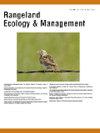为鸟类保卫和发展核心地带:灌木丛保护战略如何造福牧场鸟类
IF 2.4
3区 环境科学与生态学
Q2 ECOLOGY
引用次数: 0
摘要
依赖灌木丛(蒿属)的鸟类数量下降反映了灌木丛生态系统的整体恶化。为了应对这一生物群落的衰退,西部合作伙伴通过制定 "灌木丛保护设计"(Sagebrush Conservation Design),团结在灌木丛保护的共同愿景周围,该设计确定了被称为 "灌木丛核心区"(CSA)的高度优先区域,以支持整个生物群落的保护行动。虽然这一保护设计并没有明确考虑重点物种的分布或丰度,但其基本假设是,与鼠尾草相关的野生动物将从针对鼠尾草生物群落威胁的行动中受益。在此,我们明确检验了用于量化 CSA 的指标--鼠尾草生态完整性(SEI)是否与鼠尾草鸣禽的丰度和种群趋势相关,从而使 CSA 成为保护野生动物的有效保护伞。由于物种对不同生态因素的反应可能不同,我们进一步研究了 SEI 的五个组成部分:灌木丛覆盖率、树木覆盖率、多年生草地覆盖率、一年生草地覆盖率和人类活动对灌木丛鸣禽种群结构的相对重要性。我们发现,在所考察的三个物种中,鼠尾草麻雀(Artemisiospiza nevadensis)、布鲁尔麻雀(Spizella breweri)和鼠尾草鸫(Oreoscoptes montanus)的种群数量随着 SEI 值的增加而大幅增加。具体来说,模型支持 CSA 中的相对丰度中值比周边地区高 10 倍(鼠尾草鸫)、6 倍(布鲁尔麻雀)和 3 倍(鼠尾草麻雀)。此外,我们还发现,有确凿证据表明,在脱离 CSA 的地区,种群数量会大幅下降。最后,尽管我们发现在五个 SEI 要素的相对重要性方面存在一些物种特异性差异,但总体而言,在影响鸟类种群数量方面,鼠尾草覆盖和树木覆盖比草地覆盖更为重要。我们的研究表明,旨在保护或增加 CSA 的保护行动很可能会使依赖鼠尾草的鸣禽种群和其他重点野生动物受益,特别是如果考虑到针对 SEI 的哪个(些)组成部分的话。本文章由计算机程序翻译,如有差异,请以英文原文为准。
Defend and Grow the Core for Birds: How a Sagebrush Conservation Strategy Benefits Rangeland Birds
Population declines among sagebrush (Artemisia spp.) reliant birds mirror the larger deterioration of the sagebrush ecosystem. To combat this biome decline, western partners have unified around a common vision for sagebrush conservation by developing the Sagebrush Conservation Design, which identified high-priority areas, designated as “core sagebrush areas” (CSAs), to anchor conservation actions throughout the biome. While this conservation design did not explicitly consider the distribution or abundance of focal species, an underlying assumption has been that sagebrush-associated wildlife will benefit from actions targeting threats to the sagebrush biome. Herein, we explicitly test whether sagebrush ecological integrity (SEI), the metric used to quantify CSAs, is associated with sagebrush songbird abundance and population trends, such that CSAs provide an effective umbrella for wildlife conservation. Because species likely vary in their response to different ecological factors, we further examined the relative importance of the five components of SEI: sagebrush cover, tree cover, perennial grass cover, annual grass cover, and human modification, in structuring sagebrush songbird populations. We found substantial increases in population counts associated with increased values of SEI across three species examined: sagebrush sparrow (Artemisiospiza nevadensis), Brewer's sparrow (Spizella breweri), and sage thrasher (Oreoscoptes montanus). Specifically, models supported 10 times (sage thrasher), six times (Brewer's sparrow), and three times (sagebrush sparrow) higher median relative abundances in CSAs compared with surrounding areas. Further, we found strong evidence of large population declines as areas transitioned out of CSAs. Finally, although we found some species-specific differences in the relative importance of the five SEI components, generally, sagebrush cover and tree cover were more important than grass cover in influencing bird populations. We show that conservation actions designed to preserve or grow CSAs will likely benefit sagebrush-obligate songbird populations and other focal wildlife, especially if consideration is given to which component(s) of SEI are targeted.
求助全文
通过发布文献求助,成功后即可免费获取论文全文。
去求助
来源期刊

Rangeland Ecology & Management
农林科学-环境科学
CiteScore
4.60
自引率
13.00%
发文量
87
审稿时长
12-24 weeks
期刊介绍:
Rangeland Ecology & Management publishes all topics-including ecology, management, socioeconomic and policy-pertaining to global rangelands. The journal''s mission is to inform academics, ecosystem managers and policy makers of science-based information to promote sound rangeland stewardship. Author submissions are published in five manuscript categories: original research papers, high-profile forum topics, concept syntheses, as well as research and technical notes.
Rangelands represent approximately 50% of the Earth''s land area and provision multiple ecosystem services for large human populations. This expansive and diverse land area functions as coupled human-ecological systems. Knowledge of both social and biophysical system components and their interactions represent the foundation for informed rangeland stewardship. Rangeland Ecology & Management uniquely integrates information from multiple system components to address current and pending challenges confronting global rangelands.
 求助内容:
求助内容: 应助结果提醒方式:
应助结果提醒方式:


